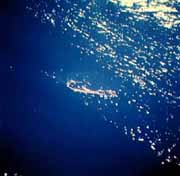May 25, 2007

Bermuda from space. Photo from www.nasa.com
Many changes have taken place over millions of years into the forming and shaping of the islands of Bermuda. Bermuda's cluster of islands is thought to be the highest point of a long ridge of volcanoes on the floor of the Atlantic (Watson, et al., 1965). Most would hear, "a long ridge along the Atlantic Ocean" and think Bermuda was formed on the Mid-Atlantic Ridge, but it turns out the volcanic rocks are not the Mid-Atlantic Ridge though they are close by. Even though geologists and researchers are not entirely sure how Bermuda was formed, there was at some point an outburst or rise in the asthenosphere.
According to Peter Vogt, the volcanism is due to a possible hotspot on the Bermuda Rise. He suggests, "The Eocene volcanism on Bermuda is paired with coeval magmatism of the Shenandoah igneous province, and both magnetic belts are associated with northeast-trending topographic bulges—the Appalachian-Labrador Rise to the west and the Bermuda Rise to the east" (Vogt, 1991). Over many years, these volcanic peaks have not only faced erosion, but have accumulated a cap of limestone on top of the volcanic rocks. Bermuda can be thought of as a "layered-cake" of sediment. The evolution of the islands took place in stages—between the sea, streams, and weather, the volcanic peaks began to erode to a more level surface. The combination of loose volcanic rock, limestone deposits, tiny marine organisms, old lava flows, sandstone and the eventual rise of coral reef helped create the islands we call Bermuda, which is now home to thousands of Bermudians.
Last modified: 5/24/2007 9:20 PM